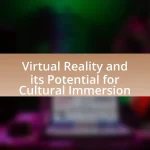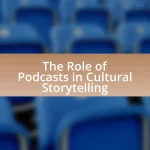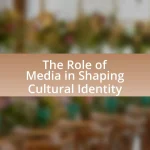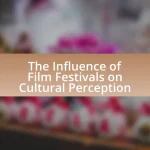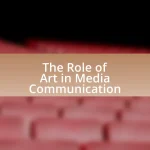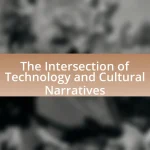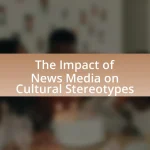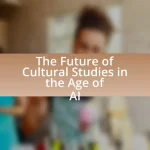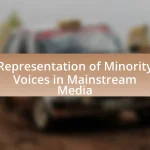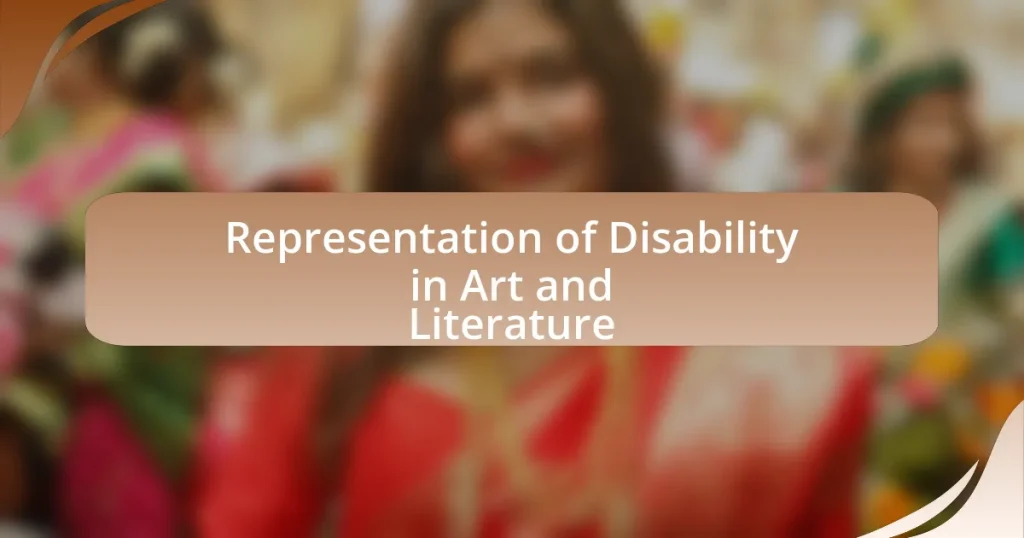The representation of disability in art and literature encompasses the portrayal of individuals with disabilities, reflecting societal attitudes and lived experiences. Historically, these representations have evolved from negative stereotypes to more nuanced and empowering depictions, influenced by cultural perceptions and social movements. Key themes explored include identity, agency, and societal perceptions, with various forms of representation such as visual art, narrative storytelling, and performance art. Contemporary works emphasize authenticity and intersectionality, challenging traditional narratives and promoting inclusivity. The article also highlights the importance of critical engagement with these representations to foster understanding and empathy towards individuals with disabilities.
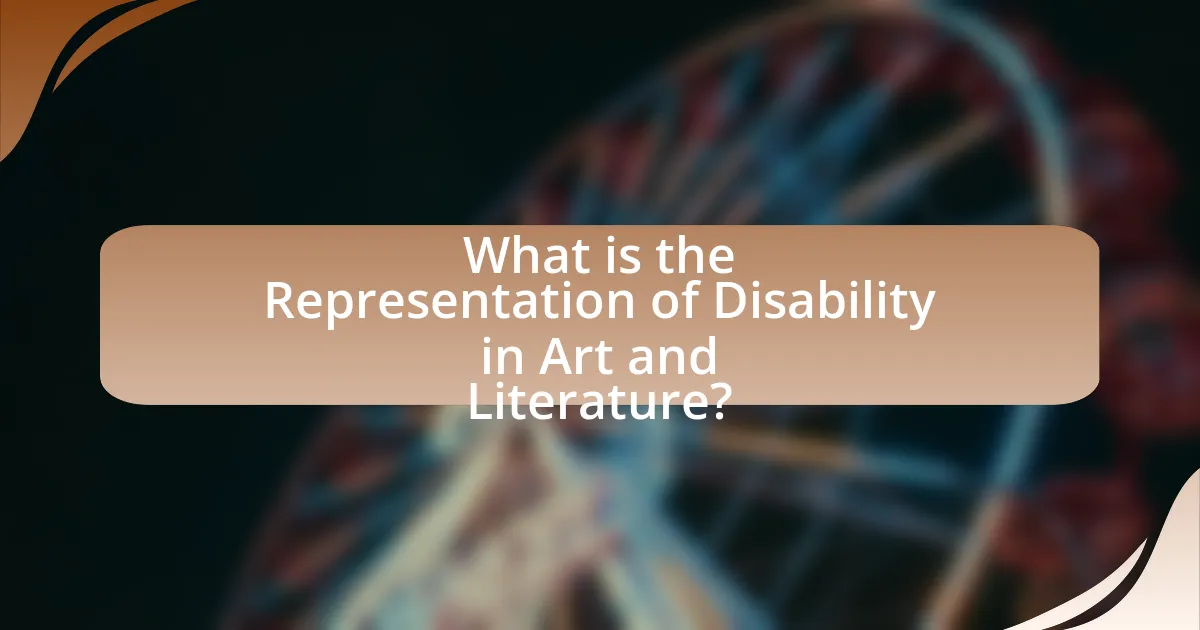
What is the Representation of Disability in Art and Literature?
The representation of disability in art and literature often reflects societal attitudes, challenges, and the lived experiences of individuals with disabilities. Historically, art and literature have portrayed disability in various ways, ranging from stigmatization and marginalization to empowerment and advocacy. For instance, in literature, works like “The Curious Incident of the Dog in the Night-Time” by Mark Haddon provide insight into the perspective of a character with autism, fostering understanding and empathy. Similarly, visual art has depicted disability through various lenses, such as Frida Kahlo’s self-portraits that explore her physical pain and identity, challenging conventional notions of beauty and normalcy. These representations can influence public perception, promote inclusivity, and encourage dialogue about the complexities of disability.
How has the representation of disability evolved over time?
The representation of disability has evolved from negative stereotypes and marginalization to a more nuanced and positive portrayal in art and literature. Historically, disabilities were often depicted as curses or punishments, as seen in ancient texts and medieval art, which reinforced societal stigma. In the 20th century, movements advocating for disability rights began to influence representations, leading to more complex characters and narratives that reflect the lived experiences of individuals with disabilities. For instance, the rise of the disability rights movement in the 1970s prompted a shift towards empowerment and authenticity in representation, as seen in works by authors like Helen Keller and later, contemporary writers such as Alice Wong. This evolution is supported by studies indicating that increased visibility and representation in media correlate with greater societal acceptance and understanding of disability.
What historical contexts have influenced these representations?
The representation of disability in art and literature has been significantly influenced by historical contexts such as the medical model of disability, social movements, and cultural attitudes towards marginalized groups. The medical model, prevalent from the 19th century, framed disability as a deficiency needing treatment, which shaped artistic portrayals that often emphasized pity or tragedy. In contrast, the disability rights movement of the late 20th century advocated for social inclusion and representation, leading to more nuanced and empowering depictions in literature and art. Additionally, cultural attitudes, such as those during the eugenics movement in the early 20th century, further stigmatized disability, impacting how artists and writers approached the subject. These historical contexts collectively inform the evolving narratives surrounding disability, reflecting broader societal changes and challenges.
How do cultural perceptions shape the portrayal of disability?
Cultural perceptions significantly shape the portrayal of disability by influencing societal attitudes and narratives surrounding disabled individuals. For instance, cultures that view disability as a tragedy often depict disabled characters in a sympathetic or pitiable light, reinforcing stereotypes of helplessness. Conversely, cultures that embrace diversity and inclusion tend to portray disabled individuals as empowered and capable, reflecting a more positive and realistic representation. Research by the World Health Organization indicates that negative cultural attitudes can lead to social exclusion and discrimination, which further impacts how disability is represented in art and literature. This interplay between cultural perception and portrayal ultimately affects public understanding and acceptance of disability.
Why is representation important in art and literature?
Representation is important in art and literature because it fosters inclusivity and reflects diverse experiences, particularly those of marginalized groups such as individuals with disabilities. When art and literature accurately portray these experiences, they challenge stereotypes and promote understanding, allowing audiences to connect with and empathize with different perspectives. Studies, such as those conducted by the National Endowment for the Arts, show that diverse representation can enhance creativity and innovation in artistic expression, ultimately enriching cultural narratives.
What impact does representation have on societal attitudes towards disability?
Representation significantly influences societal attitudes towards disability by shaping perceptions and fostering understanding. When individuals with disabilities are portrayed in diverse and authentic ways in art and literature, it challenges stereotypes and promotes empathy. For instance, research by the National Endowment for the Arts indicates that inclusive representation can lead to increased awareness and acceptance, as seen in the positive reception of works like “The Curious Incident of the Dog in the Night-Time,” which provides insight into the experiences of a character with autism. This kind of representation not only normalizes disability but also encourages dialogue, ultimately contributing to a more inclusive society.
How can art and literature challenge stereotypes about disability?
Art and literature can challenge stereotypes about disability by presenting nuanced, authentic representations of disabled individuals that counteract societal misconceptions. For instance, works like “The Curious Incident of the Dog in the Night-Time” by Mark Haddon provide insight into the experiences of a character with autism, fostering empathy and understanding. Additionally, visual art, such as the photography of Alice Wong, showcases the lives of disabled people in empowering ways, dismantling the narrative of disability as solely a tragedy. These creative expressions not only highlight the diversity of experiences within the disabled community but also encourage audiences to reconsider their preconceived notions, ultimately promoting a more inclusive perspective.

What are the different forms of representation of disability?
The different forms of representation of disability include visual representation, narrative representation, and performative representation. Visual representation encompasses images, paintings, and photography that depict individuals with disabilities, often aiming to challenge stereotypes or highlight lived experiences. Narrative representation involves storytelling in literature, film, and theater, where characters with disabilities are portrayed, influencing public perception and understanding. Performative representation refers to the enactment of disability in performance art, which can provide insight into the experiences of disabled individuals and provoke thought on societal attitudes. Each form plays a crucial role in shaping the discourse around disability, contributing to greater awareness and advocacy for inclusivity.
How do various art forms depict disability?
Various art forms depict disability by exploring themes of identity, societal perceptions, and personal experiences. Visual arts, such as painting and sculpture, often represent disabled individuals through symbolic imagery, highlighting both challenges and resilience. For instance, Frida Kahlo’s self-portraits reflect her physical pain and emotional struggles, providing insight into her lived experience. Literature frequently portrays disability as a lens for character development, as seen in works like “The Curious Incident of the Dog in the Night-Time” by Mark Haddon, which offers a perspective on autism through the protagonist’s unique viewpoint. Additionally, performance art can challenge stereotypes by showcasing the abilities of disabled artists, as exemplified by the work of the disability rights activist and performer, Judith Scott, whose fiber sculptures communicate complex narratives of isolation and connection. These representations contribute to a broader understanding of disability, emphasizing the diversity of experiences and the importance of inclusion in cultural narratives.
What role does visual art play in representing disability?
Visual art plays a crucial role in representing disability by providing a platform for marginalized voices and challenging societal perceptions. Through various mediums, artists with disabilities express their experiences, emotions, and identities, fostering greater understanding and empathy among audiences. For instance, the work of artists like Frida Kahlo and Chuck Close illustrates personal narratives of disability, which resonate with broader themes of resilience and identity. This representation not only raises awareness about the challenges faced by individuals with disabilities but also promotes inclusivity and diversity in the art world, as evidenced by initiatives like the Disability Arts Movement, which advocates for the visibility of disabled artists.
How is disability portrayed in literature across different genres?
Disability is portrayed in literature across different genres as a multifaceted experience that reflects societal attitudes, challenges, and the complexities of identity. In fiction, characters with disabilities often serve as symbols of resilience or struggle, highlighting themes of isolation or empowerment. For example, in contemporary novels, protagonists with disabilities may navigate societal barriers, showcasing both personal growth and systemic challenges. In poetry, disability can be explored through emotional depth, using metaphor and imagery to convey the lived experience. Historical literature often reflects the stigmas and misconceptions of its time, revealing how perceptions of disability have evolved. Studies, such as those by the National Endowment for the Arts, indicate that literature featuring disabled characters can influence public perception and foster empathy, demonstrating the significant role of narrative in shaping understanding of disability.
What themes are commonly explored in the representation of disability?
Common themes explored in the representation of disability include identity, societal perceptions, and the struggle for agency. Identity is often examined through the lens of how individuals with disabilities perceive themselves and how they are perceived by others, highlighting the complexities of self-identity in relation to societal norms. Societal perceptions focus on stereotypes and stigmas associated with disability, often portraying individuals as either inspirational figures or objects of pity. The struggle for agency emphasizes the desire for autonomy and the challenges faced by disabled individuals in asserting their rights and identities. These themes are prevalent in various forms of art and literature, reflecting ongoing societal dialogues about disability and inclusion.
How do themes of identity and belonging manifest in these representations?
Themes of identity and belonging manifest in representations of disability in art and literature by illustrating the complex experiences of individuals with disabilities as they navigate societal perceptions and personal self-concept. These representations often highlight the struggle for acceptance and the quest for a sense of belonging within both their immediate communities and the broader society. For instance, works like “The Curious Incident of the Dog in the Night-Time” by Mark Haddon depict the protagonist’s unique perspective shaped by autism, emphasizing how identity is intertwined with social interactions and belonging. Additionally, the portrayal of characters with disabilities often challenges stereotypes, fostering a deeper understanding of their identities and the importance of inclusive communities. This is supported by research from the National Endowment for the Arts, which indicates that diverse representations in literature and art can enhance empathy and social cohesion, thereby reinforcing the themes of identity and belonging.
What narratives are often used to depict the experiences of disabled individuals?
Narratives that are often used to depict the experiences of disabled individuals include the “overcoming adversity” narrative, the “tragic hero” narrative, and the “inspiration” narrative. The “overcoming adversity” narrative focuses on individuals who triumph over their disabilities, showcasing resilience and determination, often exemplified in stories like “The Diving Bell and the Butterfly” by Jean-Dominique Bauby. The “tragic hero” narrative portrays disabled individuals as figures of pity or loss, often seen in classic literature and films, which can reinforce stereotypes. The “inspiration” narrative presents disabled individuals as sources of motivation for others, frequently highlighted in media portrayals that emphasize their achievements despite challenges, such as in the case of athletes in the Paralympics. These narratives shape societal perceptions and influence the representation of disability in art and literature.
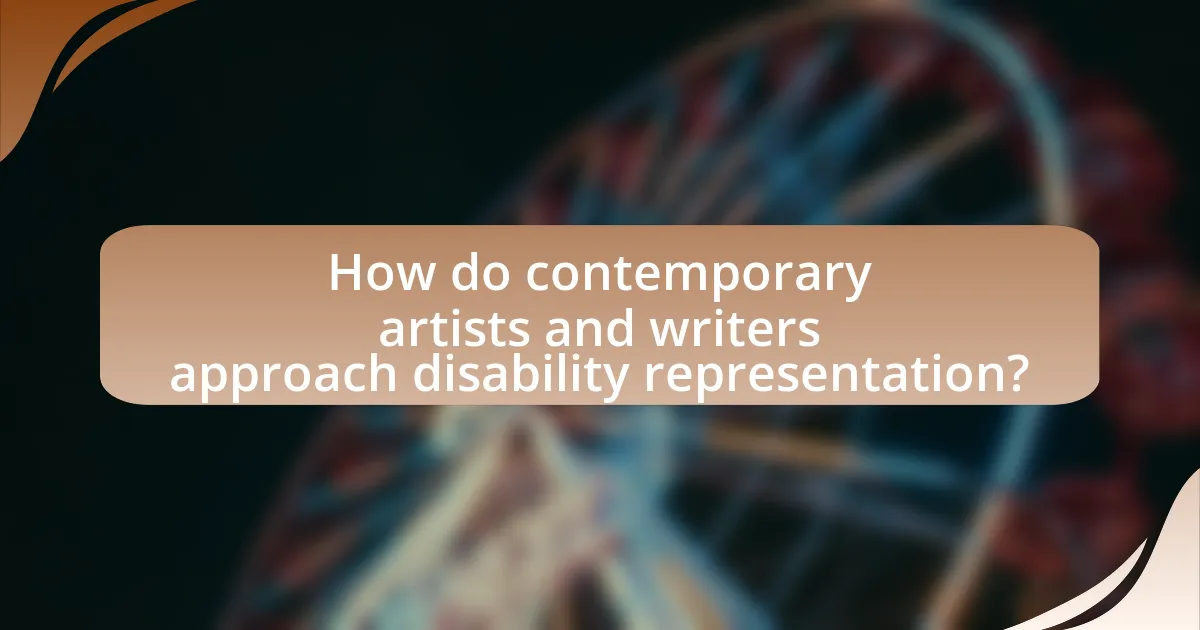
How do contemporary artists and writers approach disability representation?
Contemporary artists and writers approach disability representation by emphasizing authenticity and inclusivity, often centering the voices and experiences of disabled individuals. This approach is evident in various forms of media, where creators challenge stereotypes and advocate for a more nuanced understanding of disability. For instance, the work of artists like Judith Scott, who was deaf and had Down syndrome, showcases the complexity of identity and the richness of lived experiences, while writers such as Eli Clare explore the intersections of disability with gender and sexuality, highlighting the multifaceted nature of identity. These representations are supported by movements advocating for disability rights and visibility, which have gained momentum in recent years, leading to a broader acceptance and understanding of disability in contemporary culture.
What innovative techniques are used in modern representations of disability?
Modern representations of disability utilize innovative techniques such as intersectional storytelling, digital media, and participatory art. Intersectional storytelling integrates diverse perspectives, allowing narratives to reflect the complexities of disability alongside race, gender, and socioeconomic status, thereby fostering a more inclusive understanding. Digital media, including virtual reality and augmented reality, creates immersive experiences that challenge traditional perceptions of disability, enabling audiences to engage with the lived experiences of individuals with disabilities in a more impactful way. Participatory art invites individuals with disabilities to actively contribute to the creative process, ensuring their voices and experiences are authentically represented. These techniques collectively enhance visibility and promote a nuanced dialogue around disability in contemporary art and literature.
How do contemporary works challenge traditional narratives about disability?
Contemporary works challenge traditional narratives about disability by presenting diverse and nuanced representations that emphasize agency, identity, and lived experiences. These works often subvert stereotypes by showcasing disabled individuals as complex characters with their own narratives, rather than as mere symbols of tragedy or inspiration. For instance, literature such as “The Curious Incident of the Dog in the Night-Time” by Mark Haddon offers insight into the inner world of a protagonist with autism, highlighting their unique perspective rather than focusing solely on their disability. Additionally, visual art by creators like Judith Scott, who was born with Down syndrome, challenges conventional perceptions by transforming personal experiences into powerful artistic expressions. This shift in representation encourages audiences to reconsider preconceived notions about disability, fostering a more inclusive understanding of diverse identities.
What role does intersectionality play in current representations?
Intersectionality plays a crucial role in current representations by highlighting how various social identities, such as race, gender, and disability, intersect to shape individual experiences and societal perceptions. This framework allows for a more nuanced understanding of representation, as it reveals that individuals do not experience oppression or privilege in isolation but rather through the complex interplay of their multiple identities. For instance, studies have shown that disabled individuals from marginalized racial backgrounds face unique challenges that differ from those experienced by disabled individuals who are white, emphasizing the need for diverse and inclusive narratives in art and literature. This approach not only enriches the representation of disability but also fosters empathy and awareness among audiences, ultimately leading to more equitable portrayals in cultural discourse.
How can audiences engage with representations of disability in art and literature?
Audiences can engage with representations of disability in art and literature by actively analyzing and interpreting the themes, narratives, and characters that depict disability. This engagement can involve critical discussions that challenge stereotypes and promote understanding of the lived experiences of individuals with disabilities. Research indicates that exposure to diverse representations can foster empathy and reduce stigma; for instance, a study published in the Journal of Disability Studies in Education found that literature featuring disabled characters can enhance readers’ awareness and acceptance of disability issues. By participating in discussions, attending workshops, or creating their own art and literature that reflects disability, audiences can contribute to a more inclusive dialogue surrounding these representations.
What are some ways to critically analyze these representations?
To critically analyze representations of disability in art and literature, one can employ several methods. First, examining the historical context of the work reveals how societal attitudes towards disability have evolved, influencing the portrayal of disabled individuals. For instance, the representation of disability in literature from the 19th century often reflects prevailing stereotypes, while contemporary works may challenge these views, as seen in the shift from tragic narratives to more nuanced characterizations.
Second, analyzing the language and imagery used in the representations can uncover underlying biases or assumptions. For example, the use of metaphors that equate disability with tragedy can perpetuate negative stereotypes, while inclusive language can promote understanding and empathy.
Third, considering the perspective of the creator—whether they have a disability or are an ally—can provide insight into the authenticity of the representation. Works by disabled authors, such as “The Curious Incident of the Dog in the Night-Time” by Mark Haddon, often present more complex and realistic portrayals compared to those created by non-disabled individuals.
Lastly, engaging with critiques from disability studies scholars can deepen the analysis. Scholars like Rosemarie Garland-Thomson emphasize the importance of viewing disability as a social construct rather than a personal tragedy, which can reshape interpretations of artistic representations.
How can readers and viewers support authentic representations of disability?
Readers and viewers can support authentic representations of disability by actively seeking out and engaging with works created by disabled artists and authors. This engagement not only amplifies diverse voices but also challenges stereotypes and promotes a more nuanced understanding of disability. Research indicates that representation matters; for instance, a study by the University of Southern California found that authentic portrayals can significantly influence public perceptions and attitudes towards disability. By prioritizing and sharing these authentic narratives, audiences contribute to a cultural shift that values genuine experiences over tokenism.
What best practices should creators follow when representing disability?
Creators should prioritize authenticity and inclusivity when representing disability. This involves engaging with disabled individuals to ensure accurate portrayals and avoiding stereotypes. Research indicates that representation matters; for instance, a study by the University of Southern California found that authentic representation can lead to greater understanding and acceptance of disabilities in society. Additionally, creators should consider the diversity within the disability community, recognizing that experiences vary widely among individuals. By following these practices, creators can contribute to a more nuanced and respectful representation of disability in art and literature.
How can creators ensure respectful and accurate portrayals of disabled individuals?
Creators can ensure respectful and accurate portrayals of disabled individuals by actively involving disabled people in the creative process. This involvement can include consulting with disabled individuals, hiring disabled actors or writers, and incorporating their lived experiences into the narrative. Research shows that representation improves when creators engage with the community they aim to depict, as it fosters authenticity and reduces stereotypes. For instance, a study published in the Journal of Disability Studies highlights that narratives co-created with disabled individuals lead to more nuanced and realistic portrayals, challenging common misconceptions and promoting understanding.
What resources are available for artists and writers to improve their understanding of disability representation?
Artists and writers can access various resources to enhance their understanding of disability representation, including organizations, literature, and online platforms. Notable organizations such as the Disability Arts Network and the National Arts and Disability Center provide workshops, training, and resources focused on inclusive practices. Additionally, books like “Disability Visibility: First-Person Stories from the Twenty-First Century,” edited by Alice Wong, offer firsthand accounts that illuminate the complexities of disability experiences. Online platforms like the Disability in the Arts, Discourse, and Education (D.A.D.E.) provide articles, discussions, and community engagement opportunities that foster deeper insights into disability representation in art and literature. These resources collectively support artists and writers in creating more authentic and respectful portrayals of disability.
